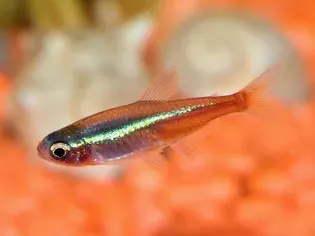Neon Tetra Disease in Fish: Treatment and Prevention
Updated on 04/26/24

Neon Tetra Disease: A Guide to Prevention and Treatment
Neon tetras are vibrant and fascinating fish, but they can unfortunately fall prey to a variety of diseases, including Neon Tetra Disease. This condition is highly contagious and can quickly spread through an aquarium, leading to devastating losses. In this comprehensive guide, we'll explore Neon Tetra Disease in detail, delving into its causes, symptoms, treatment options, and preventive measures:
Understanding Neon Tetra Disease
Neon Tetra Disease, also known as Pleistophora hyphessobryconis, is a parasitic infection caused by a microsporidian called Pleistophora hyphessobryconis. It primarily affects neon tetras (Paracheirodon innesi) and other closely related species.
Transmission and Spread
The parasite is transmitted through spores released by infected fish. These spores can survive for extended periods in water and on surfaces within the aquarium. Fish become infected when they ingest these spores, either directly or through contaminated food or water. The parasite infects the fish's muscle tissues, causing a variety of symptoms.
Symptoms of Neon Tetra Disease
Infected fish may exhibit a range of symptoms, including:
- White spots or patches: These are the most common symptom, often appearing on the body and fins.
- Loss of color: Neon tetras are known for their vibrant colors, which can fade or disappear in infected fish.
- Wasting: Fish may become emaciated as the parasite consumes their muscle tissue.
- Curved spine: In advanced stages, the spine may become curved or deformed.
- Abnormal swimming: Infected fish may swim erratically or have difficulty maintaining balance.
- Lethargy: Fish may become less active and spend more time resting on the bottom of the aquarium.
Treatment Options for Neon Tetra Disease
Unfortunately, there is no known cure for Neon Tetra Disease. However, treatment can help manage the infection and improve the fish's quality of life. Treatment options include:
- Medication: Antiparasitic medications, such as metronidazole or fenbendazole, can help to reduce the parasite load.
- Salt baths: Short-term salt baths can also be beneficial in killing the parasite on the fish's body and in the water.
- Quarantine: Infected fish should be isolated from healthy fish to prevent the spread of the disease.
- Supportive care: Providing a clean and well-maintained aquarium with plenty of fresh water and a nutritious diet can help to support the fish's immune system.
Prevention of Neon Tetra Disease
Prevention is crucial in controlling Neon Tetra Disease. Here are some key measures to follow:
- Quarantine new fish: Before introducing new fish into your aquarium, quarantine them for several weeks to monitor for signs of disease.
- Avoid overstocking: Overcrowding can stress fish and make them more susceptible to infection.
- Maintain good water quality: Regular water changes and proper filtration help to remove waste and prevent the buildup of harmful bacteria.
- Avoid live food: Live food can carry parasites and other pathogens. Consider feeding your fish high-quality, commercial fish food.
- Sanitize plants and decorations: Before adding new plants or decorations to your aquarium, sanitize them to remove potential sources of infection.
- Use a UV sterilizer: A UV sterilizer can help to kill parasites and other harmful microorganisms in the water.
Conclusion
Neon Tetra Disease is a serious infection that can have devastating consequences for neon tetras. By understanding its causes, symptoms, treatment options, and preventive measures, you can protect your fish and maintain a healthy aquarium ecosystem. Remember, early detection and intervention are crucial for managing Neon Tetra Disease and ensuring the well-being of your beloved fish.
Explore More Pets

Freshwater Aquarium Filters
How to Deal With Cloudy Aquarium Water

Saltwater Aquarium Filters
How Do You Remove Chloramines From Tap Water?

Freshwater Aquariums & Habitat
Can I Keep My Koi Fish Inside?

Saltwater Aquariums & Habitat
14 Best Floating Plants for Your Aquarium

Freshwater Fish Health
How to Treat Ich on Freshwater Fish

Saltwater Fish Health
Fin Rot in Aquarium Fish

Freshwater Aquarium Filters
How to Do Aquarium Water Changes

Saltwater Fish Health
How Do Fish Get Parasites?